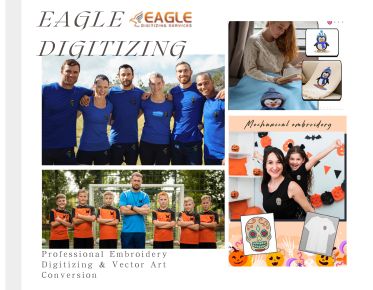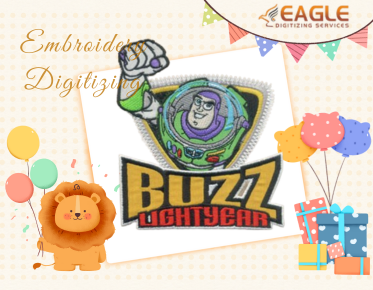Blending Old and New: Digitized Embroidery on Clothing
The realm of embroidery, rich with cultural history and artistic expression, has undergone a remarkable transformation with the advent of digital technology. The fusion of tradition and technology offers endless possibilities, breathing new life into age-old patterns and techniques. Digitized embroidery is rapidly gaining popularity, not just for its efficiency but for its ability to preserve and enhance traditional designs in innovative ways.
The Fusion of Tradition and Technology
Embroidery has always been a meticulous art form, requiring skill and patience. By integrating digital technology, we can maintain the intricate beauty of traditional designs while streamlining the process. This blend of old and new allows for precision and creativity, pushing the boundaries of what can be achieved in textile art.
The Cultural Significance of Embroidery
Embroidery holds deep cultural significance, often symbolizing heritage, identity, and artistry. From the elaborate sarees of India to the vibrant kimonos of Japan, each stitch tells a story. Digitized embroidery respects and preserves these cultural narratives while offering new avenues for expression and preservation.
Digitizing Cultural Patterns
Adapting Traditional Motifs Digitally
Adapting traditional motifs digitally involves translating hand-drawn or historical designs into digital formats. This process requires careful attention to detail, ensuring that the digital version captures the essence of the original motif. Use digitizing software to trace and refine the design, preserving its cultural significance.
Preserving Cultural Heritage Through Digitizing
Digitizing traditional patterns helps preserve cultural heritage by making these designs accessible for future generations. Digital formats can be stored, shared, and reproduced easily, ensuring that traditional artistry is not lost over time.
Examples of Digitized Cultural Designs
Examples of digitized cultural designs include intricate floral patterns from Indian sarees, geometric motifs from African textiles, and delicate cherry blossom designs from Japanese kimonos. These designs, when digitized, retain their cultural essence while benefiting from the precision and versatility of digital embroidery.
Working with Intricate Details
Tips for Digitizing Small and Complex Elements
Digitizing small and complex elements requires precision and patience. Use high-resolution images and zoom in to capture every detail. Adjust stitch density and types to ensure clarity and avoid overcrowding. Test stitch-outs on similar fabric to refine the design.
Balancing Detail and Readability
Balancing detail and readability is crucial for intricate designs. Simplify overly complex elements without losing the essence of the design. Ensure that small details are clear and legible, especially when viewed from a distance.
Avoiding Common Mistakes in Fine Details
Common mistakes include using too high stitch density, leading to bulky and stiff embroidery, and neglecting the underlay stitches, which provide the necessary support. Use light underlay stitches and adjust stitch density to maintain clarity and prevent distortion.
Scaling Designs for Different Garments
Adjusting Designs for Various Clothing Items
Adjusting designs for different garments involves resizing and repositioning the design to suit the specific item. Ensure that the design fits well and enhances the garment’s overall look. Consider the garment's shape, size, and fabric when making adjustments.
Maintaining Proportion and Balance
Maintaining proportion and balance is essential for a harmonious design. When scaling up or down, ensure that all elements of the design remain proportional. Use software tools to preview and adjust the design, ensuring it looks balanced on the garment.
Examples of Scaled Traditional Designs
Examples of scaled traditional designs include large floral motifs on lehengas, intricate borders on sarees, and delicate patterns on kimonos. Each design is adjusted to suit the specific garment, ensuring that the embroidery enhances its overall aesthetic.
Incorporating Modern Elements
Blending Traditional and Contemporary Styles
Blending traditional and contemporary styles creates unique and innovative designs. Combine classic motifs with modern elements like abstract patterns or geometric shapes. This fusion results in fresh, appealing designs that honor tradition while embracing modernity.
Adding Modern Flair to Classic Patterns
Add modern flair to classic patterns by experimenting with colors, textures, and placements. Use unconventional color schemes or metallic threads to give traditional designs a contemporary twist. This approach revitalizes classic patterns and makes them relevant to modern fashion.
Case Studies of Successful Fusions
Successful fusions include contemporary lehengas featuring traditional embroidery with modern silhouettes, or kimonos adorned with traditional motifs in vibrant, modern colors. These designs showcase the creative potential of blending old and new, resulting in garments that are both timeless and trendy.
Digitized Embroidery on Different Traditional Clothing
Embroidering Sarees and Lehengas
Sarees and lehengas are perfect canvases for digitized embroidery. Use intricate borders, elaborate motifs, and detailed pallu designs to enhance these traditional garments. Ensure that the embroidery complements the fabric and overall design of the saree or lehenga.
Digitizing Designs for Kimonos and Hanboks
Kimonos and hanboks feature unique patterns and motifs that require careful digitizing. Focus on traditional elements like floral motifs, nature-inspired designs, and geometric patterns. Ensure that the embroidery respects the cultural significance and aesthetics of these garments.
Traditional African Attire and Digitized Embroidery
African attire, with its vibrant colors and bold patterns, offers exciting opportunities for digitized embroidery. Capture the essence of traditional motifs and adapt them digitally to create stunning designs that celebrate African heritage.
Native American Clothing and Modern Embroidery
Native American clothing often features intricate beadwork and embroidery. Digitized embroidery can replicate these designs, ensuring that they retain their cultural significance. Use traditional patterns and colors to create authentic and respectful designs.
Embroidering Accessories
Digitizing for Scarves, Shawls, and Dupattas
Scarves, shawls, and dupattas offer versatile canvases for digitized embroidery. Use detailed borders, corner motifs, and all-over patterns to enhance these accessories. Ensure that the embroidery is lightweight and drapes well.
Embroidery on Bags and Footwear
Digitized embroidery can elevate bags and footwear, adding a unique touch. Use durable threads and appropriate stabilizers to ensure longevity. Customize designs to suit different styles, from traditional patterns to modern motifs.
Enhancing Accessories with Digitized Patterns
Enhance accessories like belts, headbands, and hats with digitized embroidery. Use small motifs and delicate patterns to add a touch of elegance and personalization. Ensure that the embroidery complements the accessory’s design and material.
Customizing Traditional Outfits
Personalizing Designs for Unique Looks
Personalizing traditional outfits with digitized embroidery adds a unique and special touch. Add names, dates, or personal messages to create custom garments that hold sentimental value. Use elegant fonts and appropriate placements to enhance the overall design.
Adding Names, Dates, and Special Messages
Incorporate names, dates, and special messages into traditional designs for a personalized touch. Use delicate fonts and thoughtful placements to ensure that the additions blend seamlessly with the overall design.
Tailoring Embroidery for Special Occasions
Tailor embroidery for special occasions like weddings, festivals, and celebrations. Use luxurious threads, intricate designs, and meaningful motifs to create garments that are both beautiful and significant.
Ensuring Durability and Longevity
Techniques for Long-Lasting Embroidery
Ensure the durability and longevity of digitized embroidery by using quality materials and proper techniques. Secure stitches, appropriate underlay, and careful tension adjustments prevent wear and tear, ensuring the embroidery remains intact over time.
Choosing Quality Materials
Quality materials, including high-grade threads and stable fabrics, are crucial for long-lasting embroidery. Invest in reputable brands and avoid compromising on materials to ensure that the embroidery withstands regular use and washing.
Caring for Digitized Embroidered Garments
Proper care ensures that digitized embroidered garments retain their beauty. Follow washing instructions, avoid harsh detergents, and store garments carefully. Regular maintenance helps preserve the embroidery’s quality and appearance.
Cost Considerations
Budgeting for Digitized Embroidery Projects
Budgeting for digitized embroidery projects involves considering the cost of software, materials, and labor. Plan carefully to balance quality and cost, ensuring that the project remains affordable without compromising on results.
Comparing Costs: Hand-Embroidered vs. Digitized
Compare the costs of hand-embroidered and digitized projects. While hand embroidery offers unique artisanal value, digitized embroidery provides consistency and efficiency. Evaluate the specific needs of your project to choose the most cost-effective method.
Cost-Effective Tips for High-Quality Results
Achieve high-quality results without overspending by using efficient techniques and sourcing materials wisely. Opt for user-friendly software, invest in quality threads and fabrics, and practice regularly to improve your skills and efficiency.
Collaborating with Artisans and Designers
Working with Traditional Artisans
Collaborating with traditional artisans brings authenticity and depth to digitized embroidery projects. Combine their expertise with modern technology to create designs that honor tradition while embracing innovation.
Blending Artistic Vision with Technology
Blend artistic vision with technology by working closely with designers and digitizers. Ensure that the final design reflects the creative input of all collaborators, resulting in unique and beautiful embroidery.
Successful Collaborations and Their Outcomes
Successful collaborations between artisans and digitizers result in stunning designs that respect tradition and embrace modernity. Examples include traditional garments with modern touches, unique accessories, and custom pieces that tell a story.
Showcasing and Marketing Your Work
Creating a Portfolio of Digitized Embroidery
Build a portfolio showcasing your best-digitized embroidery work. Include high-quality images, detailed descriptions, and information about the design process. A well-curated portfolio attracts clients and demonstrates your skills.
Marketing Strategies for Traditional Embroidery
Market traditional embroidery by highlighting its cultural significance and artistic value. Use social media, online platforms, and local events to reach a broader audience. Share behind-the-scenes insights and stories to engage and attract customers.
Utilizing Social Media and Online Platforms
Leverage social media and online platforms to showcase your work and reach potential clients. Post regularly, use hashtags, and engage with your audience. Online platforms like Etsy or Instagram provide excellent opportunities to market and sell your embroidered products.
Digitized embroidery on traditional clothing offers a unique blend of tradition and technology, preserving cultural heritage while embracing modern techniques. From selecting the right software to choosing quality materials, each step is crucial for achieving beautiful and lasting results. Embrace the blend of tradition and innovation in your embroidery projects. Use digital tools to enhance traditional designs, creating unique and meaningful pieces that honor the past while looking toward the future.
Explore the world of digitized embroidery with curiosity and creativity. Experiment with different techniques, collaborate with artisans, and continually refine your skills. The fusion of tradition and technology opens up endless possibilities for beautiful and meaningful embroidery.



.png)